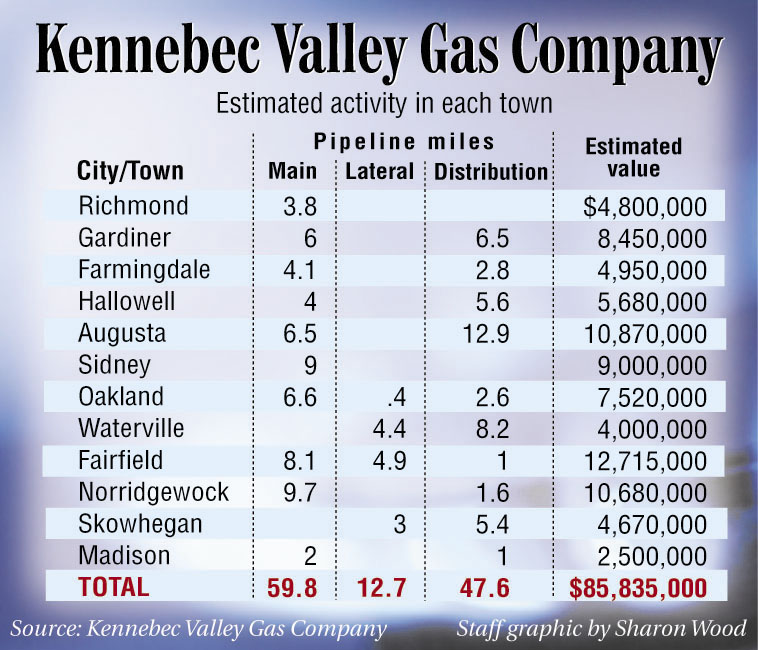AUGUSTA — A natural gas pipeline forming a spine through the Kennebec Valley region would help spur economic growth and more business opportunities, Richard Silkman told a group of area business people on Wednesday.
“It makes economic sense today,” said Silkman, an economist and one of three partners in Portland-based Kennebec Valley Gas Co.
Silkman pitched his company’s proposal for a pipeline project that would carry natural gas through and to communities along a 60-mile corridor from Richmond to Madison. He provided about 60 members of the Kennebec Valley Chamber of Commerce with details of the estimated $85 million project during a business breakfast at the Senator Inn on Western Avenue.
Silkman presented slides of graphs showing that the price per British thermal unit for natural gas — which is marketed within a continent — is lower and less volatile than oil, which is marketed internationally.
So far, the project, which would originate at the Maritimes & Northeast Pipeline compressor station in Richmond, has received conditional certification from the Maine Public Utilities Commission as a gas utility.
The Kennebec Valley Gas Co. project also is being pitched to municipal leaders because the company principals are seeking tax increment financing agreements with all 12 communities along the proposed line.
“We are connecting customers over time,” Silkman said. “What we asked (the municipalities) for is a TIF in which we got a significant portion of the tax revenue so we could pay our debt service early.”
Under the proposed 15-year TIF, the natural gas company would keep 80 percent of property taxes on the pipeline for the first 10 years, and keep 60 percent of that revenue for the final five years.
Silkman said the project hinges on long-term commitments by three large paper mills as customers — Huhtamaki Packing in Waterville, Sappi Paper in Skowhegan and Madison Paper Industries. He likened them to anchor tenants in a big mall project.
Without those large-volume customers, the project would not be financially feasible, he said.
The next tier of customers the company hopes to sign on would be large institutions, such as Colby College in Waterville, the University of Maine at Augusta and multiple locations of Hannaford supermarkets and MaineGeneral Health operations, among other operations.
Silkman estimated that large commercial customers could have a 30 to 40 percent reduction in fuel costs.
He estimated total energy savings for all the larger volume users at $20-$25 million a year, as measured against estimated 2012 oil prices.
“That money would not be going out of the region; it would stay here and help development in Maine,” Silkman said.
The high pressure steel pipeline would range in diameter from 6 inches to 8 inches and run along an existing public right of way, essentially buried under roadways. That would simplify construction permitting requirements, he said.
“We’re using property not subject to tax today,” Silkman said.
On paper, the line shows local loops — where residential and commercial customers could access the pipeline — in Gardiner, Farmingdale, Hallowell, Augusta, Waterville, Madison and Skowhegan. Lateral lines off the main pipe would run in Oakland, Waterville, Fairfield and Skowhegan.
“A lateral is a line off the main line designed to serve a major end-user,” Silkman said. “The laterals are off the main line to the Sappi Mill and off the main line to the Huhtamaki Plant in Waterville. All of the rest of the facilities are distribution facilities.”
Because the project could be constructed simultaneously at multiple points along the route, Silkman offered what he termed an aggressive schedule, showing the pipeline in service by the end of 2013.
“Every year we delay is $20-25 million going out of the region and not staying in,” Silkman said.
The Kennebec Valley Gas Co. worked with the Kennebec Valley Council of Governments to gain agreement in principle from representatives of 11 of the 12 communities.
So far, however, only Augusta has agreed to a TIF for the project. It is under consideration at various stages in most of the other communities, including Fairfield, Farmingdale, Gardiner, Hallowell, Madison, Norridgewock, Oakland, Richmond, Skowhegan, Sidney and Waterville.
“You really do want to have them all on board,” Silkman said.
Responding to questions from chamber members, Silkman said, “Without the TIFs, the project can’t get built.” He also said the project is “designed to allow economic development for the towns.”
“We are not asking for any subsidies for the fuel itself; the TIF is only for the infrastructure,” Silkman said.
Silkman also told the chamber members — several of whom represent local oil dealerships — that there would be opportunity for businesses to hookup the customers since the pipeline company would be responsible for delivering gas to the point of the meter.
Any retrofitting or conversion to use the gas itself would be done by local companies, many of which already work with propane gas.
“The leap (in certification) from propane to natural gas is not very significant,” Silkman said.
Betty Adams — 621-5631
badams@centralmaine.com
Send questions/comments to the editors.




Success. Please wait for the page to reload. If the page does not reload within 5 seconds, please refresh the page.
Enter your email and password to access comments.
Hi, to comment on stories you must . This profile is in addition to your subscription and website login.
Already have a commenting profile? .
Invalid username/password.
Please check your email to confirm and complete your registration.
Only subscribers are eligible to post comments. Please subscribe or login first for digital access. Here’s why.
Use the form below to reset your password. When you've submitted your account email, we will send an email with a reset code.